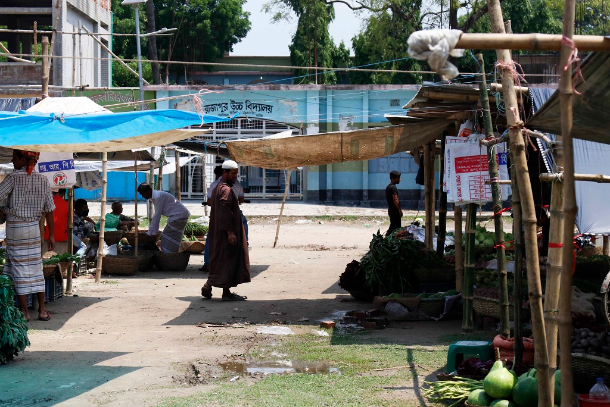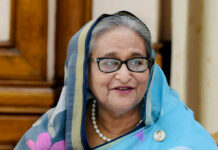
The grounds of Rajapur High School in Natore district of Bangladesh have been turned into a marketplace during the extended closure due to the coronavirus pandemic. (Photo: Stephan Uttom/UCA News)
Stephan Uttom and Rock Ronald Rozario, Dhaka
Bangladesh
May 11, 2020
Samuel Hasdak is full of anxiety and stress about the future of his education.
Hasdak, 15, is an ethnic Santal Catholic and 10th grader from the Ghoraghat area of Dinajpur district in northern Bangladesh. Like all students of Catholic-run John Marie Vianney High School, he has not been to class since March 17, the day the government declared the closure of all education institutes due to the Covid-19 pandemic.
In a recent announcement, the authorities advised that if the situation doesn’t improve, education institutes might remain closed up to September.
“After the school shut, our boarding hostel also closed down, so I moved home. I have been trying to do my studies myself, but education life is in limbo now,” Hasdak told UCA News.
He came to know from a teacher that the government had started classes on TV and online, but he cannot access them as his family cannot afford a TV, smartphone and internet.
“I could catch up a bit if I could attend TV or online classes, but it is not possible. Only God knows what will happen to us if it continues,” Hasdak said.
Sumon Roy, 14, a Hindu and ninth grader at Lalon High School in Kushtia district, has been trying hard to make up valuable time of education lost during the pandemic.
Like Hasdak, he has been at home since school closed on March 17 and his family has no TV, smartphone or internet. He walks more than one kilometer every day to attend TV classes and to take notes from a teacher.
“But it is not possible to attend all classes and I have missed about half of the classes already. I secured an A+ in the eighth grade, but I doubt I can keep up the result this year,” he said.
Like Roy and Hasdak, tens of thousands of students in rural and impoverished areas of Bangladesh are in great difficulty with their education.
The government has been conducting classes on Parliament TV from morning to evening, while many government and private education institutes have adopted online classes.
However, students from poor rural families are unable to reap the benefits.
Anxiety and confusion
Holy Cross Brother Ranjan Purification, headmaster of St. Mary’s Junior High School in Alikadam in hilly, forested Bandanban district, is anxious about the fate of his 364 students.
“There is no electricity in most houses among the hills, so TV or online classes mean nothing for the students. I have advised our teachers to follow the classes and take notes to support students. In the absence of computers and smartphones, our teachers are doing it at school campus,” Brother Purification told UCA News.
Students supposed to take JSC (Junior School Certificate) exams after grade eight this year are mostly troubled and the school is worried about them, he said.
“They will have little time for preparation, and on the other hand the government might reduce the syllabus, which means the students will be at a loss. We have decided that when school opens, we will conduct classes every day of the week,” he added.
Soma Rani Barua, a government education officer in Bandardan, admitted challenges with TV and online education.
“Classes are useful but these are not accessible to all and students cannot ask questions if anything is unclear. We have told teachers to download classes and use them when they can,” Barua told UCA News.
Education institutes have been instructed not to hold exams immediately after reopening so that students get some time for preparations, she said.
Meanwhile, things have turned out even worse for some schools. Church-run St. Francis Xavier’s Junior High School, which teaches up to grade eight in Pabna district, has decided to repeat all classes next year and to halve teachers’ salaries for the rest of this year.
“The decision was made after a meeting of teachers and school committee. Teachers said they cannot make up the lost time if the school opens in September, so it is best to repeat the classes,” a community leader told UCA News on condition of anonymity.
Poverty poses challenge to education
According to the Education Ministry, Bangladesh has about 10.75 million students in primary level (grades one to eight) and about 10.50 million students in secondary and higher secondary level (grades nine to 12).
The majority of students are from rural areas, which make up 80 percent of Muslim-majority, largely agrarian Bangladesh, and about one quarter are classified as extremely poor.
The government has managed to record 200 classes for secondary students and 100 classes for primary students with teachers from Dhaka and the program is being extended, said Probir Kumar Bhattacharya, director-general of the Secondary and Higher Secondary Education Department.
“We know that about 15 percent of students are unable to attend TV classes, and we are thinking about how to reach and help them,” he told UCA News.
Catholic education institutes are following government instruction to keep in touch with teachers and students during the closure, said Jyoti F. Gomes, secretary of the Bangladesh Catholic Education Board.
“All education institutes are closed but we are in touch with teachers, and those who are able have started online classes for students. Since most have no access to devices or even a TV, teachers encourage them to attend classes with those who have some access,” Gomes told UCA News.
The government can decide to open schools in low-infected areas with strict guidelines for social distancing, he noted.
“This will be a difficult year for education, which will require extra efforts like additional classes during weekends and holidays for recovery,” Gomes added.










